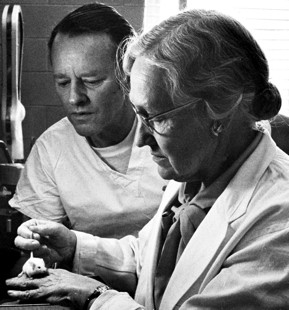Discovering a Cause of Bacterial Meningitis and an Effective Antiserum Therapy

Pittman, Margaret
Courtesy of the U.S. Food and Drug Administration
Infection with the bacterium Hemophilus influenzae causes often-fatal meningitis in young children, and until an effective vaccine came into use in the mid-1990s, it was the most common cause of acquired mental retardation and blindness in the developed world. In the early 1930s Margaret Pittman (1901-1995) discovered that there are six types of H. influenzae, only one of which is linked to meningitis in young children. Pittman then developed a therapeutic antiserum to treat the disease. Other researchers brought this early therapy into general use in the 1940s. Pittman's research also laid the groundwork for the later development of a conjugate vaccine against the infection—a vaccine that has eliminated Hemophilus meningitis in the countries where it is used.
Beginning in 1929, Pittman, working in the laboratory of Rufus Cole at the Rockefeller Hospital, began studying a large number of strains of H. influenzae isolated from infected patients. She found that the bacterium could exist in two forms. The first, more virulent form, grew in large, smooth-looking colonies, and appeared under the microscope to be surrounded by a capsule. Of six encapsulated strains that Pittman isolated, one, which she labeled type b, invariably came from children with Hemophilus meningitis. Bacteria of the second form grew in smaller, rough-looking colonies, and had no capsule. Pittman's findings echoed those of another Rockefeller Hospital laboratory—Oswald Avery's research group had, in the 1920s, discovered that the virulence of pneumococcus, a bacterium that causes pneumonia, was linked to the organism's capsule.
Pittman carried out these studies early in her career. She had received the AB from Hendrix College in 1923, and the PhD from the University of Chicago in 1929. She was an assistant at the Rockefeller Institute from 1928 to 1934. After a two-year appointment at the New York State Department of Health, she joined the National Institutes of Health in 1936. Best remembered for her work on an improved and standardized pertussis (whooping cough) vaccine, Pittman spent the rest of her career at NIH. She was the first woman there to hold the position of laboratory chief, heading the Laboratory of Bacterial Products, Division of Biologics and Standards, from 1957 to 1971. A lectureship was established in her name at NIH in honor of her accomplishments. She also was recognized with the Federal Women's Award in 1970, and served as president of the Society of American Bacteriologists and of the Washington Academy of Sciences.
Selected Publications
Pittman M. The "S" and "R" forms of Hemophilus influenzae. Proc Soc Exp Biol Med, 1930, 27: 299-301
Pittman M. Variation and type specificity in the bacterial species Hemophilus influenzae. J Exp Med, 1931, 53: 471-492
http://www.jem.org/cgi/reprint/53/4/471
Pittman M. The action of type-specific Hemophilus influenzae antiserum. J Exp Med, 1933, 58: 683-706
http://www.jem.org/cgi/reprint/58/6/683
